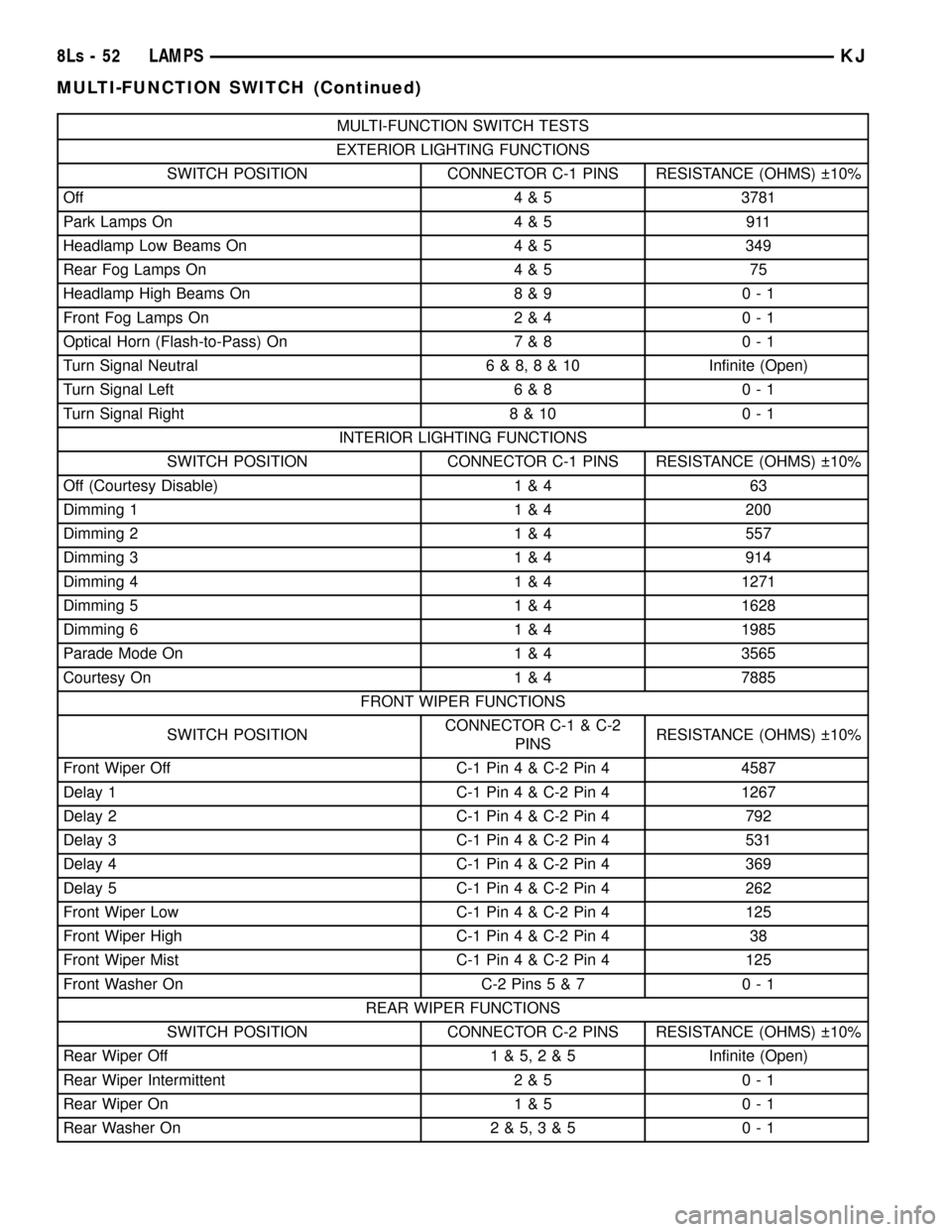signal JEEP LIBERTY 2002 KJ / 1.G Manual Online
[x] Cancel search | Manufacturer: JEEP, Model Year: 2002, Model line: LIBERTY, Model: JEEP LIBERTY 2002 KJ / 1.GPages: 1803, PDF Size: 62.3 MB
Page 575 of 1803

the cancel actuator when the steering wheel is
rotated to the left, but will unlatch the cancel actua-
tor as the steering wheel rotates to the right and
returns to center, which will cancel the turn signal
event and release the control stalk from the detent so
it returns to the neutral Off position. When a turn
signal is activated, the multi-function switch provides
a ground output on a right or left turn switch sense
circuit to the combination flasher circuitry within the
hazard switch, and the combination flasher flashes
the turn signal lamps.
RIGHT CONTROL STALK The right (wiper) con-
trol stalk of the multi-function switch operates as fol-
lows:
²Continuous Front Wipe Modes- The control
knob on the end of the multi-function switch right
(wiper) control stalk is rotated to an intermediate
detent that is one detent rearward (counterclockwise)
from the full forward (clockwise) detent to select the
low speed continuous front wiper mode, or to its full
forward (clockwise) detent to select the high speed
continuous front wiper mode. The multi-function
switch provides a resistor multiplexed output to the
Body Control Module (BCM) on a front wiper switch
mux circuit, and the BCM responds by energizing the
wiper on/off relay in the Power Distribution Center
(PDC) for the front low speed continuous wipe mode,
or the wiper on/off relay and the wiper high/low relay
in the PDC for the front high speed continuous wipe
mode as required.
²Continuous Rear Wipe Mode- The control
ring on the multi-function switch right (wiper) con-
trol stalk is rotated to the most forward (clockwise)
detent to select the continuous rear wiper mode. The
multi-function switch provides a battery current out-
put to the rear wiper motor on a rear wiper on driver
circuit to signal the rear wiper motor to operate in
the continuous wipe mode.
²Front Washer Mode- The right (wiper) control
stalk of the multi-function switch is pulled towards
the steering wheel to momentarily activate the
washer pump in the front washer mode. The washer
pump will continue to operate in the front washer
mode until the control stalk is released. The multi-
function switch provides a ground output on a
washer pump sense circuit, and battery current on a
washer pump driver circuit to energize the washer
pump in the front washer mode.
²Front Wiper Mist Mode- The right (wiper)
control stalk of the multi-function switch is pushed
towards the floor to momentarily activate the front
wiper motor in the mist mode. The front wiper motor
will continue to operate in the mist mode until the
control stalk is released. The multi-function switch
provides a resistor multiplexed output to the Body
Control Module (BCM) on a front wiper switch muxcircuit, and the BCM responds by energizing the
wiper on/off relay in the Power Distribution Center
(PDC) to operate the front wiper motor momentarily
at low speed to provide the front wiper mist mode.
²Intermittent Front Wipe Mode- The control
knob on the end of the multi-function switch right
(wiper) control stalk is rotated to one of five minor
intermediate detents to select the desired intermit-
tent front wipe delay interval. The control knob is
rotated rearward (counterclockwise) to increase the
delay, or forward (clockwise) to decrease the delay.
The multi-function switch provides a resistor multi-
plexed output to the Body Control Module (BCM) on
a front wiper switch mux circuit, and the BCM
responds by energizing the wiper on/off relay in the
Power Distribution Center (PDC) to operate the front
wiper motor at the selected delay intervals.
²Intermittent Rear Wipe Mode- The control
ring on the multi-function switch right (wiper) con-
trol stalk is rotated to the center detent to select the
intermittent rear wiper mode. The multi-function
switch provides a battery current output to the rear
wiper motor on a rear wiper intermittent driver cir-
cuit to signal the rear wiper motor to operate in the
intermittent wipe mode.
²Rear Washer Mode- The control ring on the
multi-function switch right (wiper) control stalk is
rotated to either the full forward (clockwise) or full
rearward (counterclockwise) momentary positions to
activate the washer pump in the rear washer mode.
The washer pump will continue to operate in the rear
washer mode until the control ring is released. The
multi-function switch provides a ground output on a
washer pump driver circuit, and battery current on a
washer pump sense circuit to energize the washer
pump in the rear washer mode.
DIAGNOSIS AND TESTING - MULTI-FUNCTION
SWITCH
Refer to the appropriate wiring information. The
wiring information includes wiring diagrams, proper
wire and connector repair procedures, details of wire
harness routing and retention, connector pin-out
information and location views for the various wire
harness connectors, splices and grounds.
8Ls - 50 LAMPSKJ
MULTI-FUNCTION SWITCH (Continued)
Page 577 of 1803

MULTI-FUNCTION SWITCH TESTS
EXTERIOR LIGHTING FUNCTIONS
SWITCH POSITION CONNECTOR C-1 PINS RESISTANCE (OHMS) 10%
Off 4 & 5 3781
Park Lamps On 4 & 5 911
Headlamp Low Beams On 4 & 5 349
Rear Fog Lamps On 4 & 5 75
Headlamp High Beams On 8 & 9 0 - 1
Front Fog Lamps On 2 & 4 0 - 1
Optical Horn (Flash-to-Pass) On 7 & 8 0 - 1
Turn Signal Neutral 6 & 8,8&10Infinite (Open)
Turn Signal Left 6 & 8 0 - 1
Turn Signal Right 8 & 10 0 - 1
INTERIOR LIGHTING FUNCTIONS
SWITCH POSITION CONNECTOR C-1 PINS RESISTANCE (OHMS) 10%
Off (Courtesy Disable) 1 & 4 63
Dimming 1 1 & 4 200
Dimming 2 1 & 4 557
Dimming 3 1 & 4 914
Dimming 4 1 & 4 1271
Dimming 5 1 & 4 1628
Dimming 6 1 & 4 1985
Parade Mode On 1 & 4 3565
Courtesy On 1 & 4 7885
FRONT WIPER FUNCTIONS
SWITCH POSITIONCONNECTOR C-1 & C-2
PINSRESISTANCE (OHMS) 10%
Front Wiper Off C-1 Pin 4 & C-2 Pin 4 4587
Delay 1 C-1 Pin 4 & C-2 Pin 4 1267
Delay 2 C-1 Pin 4 & C-2 Pin 4 792
Delay 3 C-1 Pin 4 & C-2 Pin 4 531
Delay 4 C-1 Pin 4 & C-2 Pin 4 369
Delay 5 C-1 Pin 4 & C-2 Pin 4 262
Front Wiper Low C-1 Pin 4 & C-2 Pin 4 125
Front Wiper High C-1 Pin 4 & C-2 Pin 4 38
Front Wiper Mist C-1 Pin 4 & C-2 Pin 4 125
Front Washer On C-2 Pins5&7 0-1
REAR WIPER FUNCTIONS
SWITCH POSITION CONNECTOR C-2 PINS RESISTANCE (OHMS) 10%
Rear Wiper Off 1 & 5,2&5Infinite (Open)
Rear Wiper Intermittent 2 & 5 0 - 1
Rear Wiper On 1 & 5 0 - 1
Rear Washer On 2 & 5,3&5 0-1
8Ls - 52 LAMPSKJ
MULTI-FUNCTION SWITCH (Continued)
Page 578 of 1803

(4) If the multi-function switch fails any of the
continuity or resistance tests, replace the faulty
switch unit as required.
REMOVAL
WARNING: ON VEHICLES EQUIPPED WITH AIR-
BAGS, DISABLE THE SUPPLEMENTAL RESTRAINT
SYSTEM BEFORE ATTEMPTING ANY STEERING
WHEEL, STEERING COLUMN, DRIVER AIRBAG,
PASSENGER AIRBAG, SEAT BELT TENSIONER,
FRONT IMPACT SENSORS, SIDE CURTAIN AIRBAG,
OR INSTRUMENT PANEL COMPONENT DIAGNOSIS
OR SERVICE. DISCONNECT AND ISOLATE THE
BATTERY NEGATIVE (GROUND) CABLE, THEN
WAIT TWO MINUTES FOR THE SYSTEM CAPACI-
TOR TO DISCHARGE BEFORE PERFORMING FUR-
THER DIAGNOSIS OR SERVICE. THIS IS THE ONLY
SURE WAY TO DISABLE THE SUPPLEMENTAL
RESTRAINT SYSTEM. FAILURE TO TAKE THE
PROPER PRECAUTIONS COULD RESULT IN ACCI-
DENTAL AIRBAG DEPLOYMENT AND POSSIBLE
PERSONAL INJURY.
(1) Disconnect and isolate the battery negative
cable.
(2) If the vehicle is equipped with the optional tilt
steering column, move the tilt steering column to the
fully lowered position and leave the tilt release lever
in the released (down) position.
(3) From below the steering column, remove the
two screws that secure the lower shroud to the upper
shroud (Fig. 52).
(4) Using hand pressure, push gently inward on
both sides of the upper shroud near the parting line
between the upper and lower shrouds to release the
snap features that secure the two halves to each
other.
(5) Remove both the upper and lower shrouds from
the steering column.
(6) Disconnect the two instrument panel wire har-
ness connectors for the multi-function switch from
the two connector receptacles on the back of the
switch housing.
(7) Remove the multi-function switch from the
steering column lock housing by carefully rocking the
switch and pulling the switch housing upward far
enough to disengage its alignment posts and locator
tabs from the lock housing.
INSTALLATION
WARNING: ON VEHICLES EQUIPPED WITH AIR-
BAGS, DISABLE THE SUPPLEMENTAL RESTRAINT
SYSTEM BEFORE ATTEMPTING ANY STEERING
WHEEL, STEERING COLUMN, DRIVER AIRBAG,
PASSENGER AIRBAG, SEAT BELT TENSIONER,FRONT IMPACT SENSORS, SIDE CURTAIN AIRBAG,
OR INSTRUMENT PANEL COMPONENT DIAGNOSIS
OR SERVICE. DISCONNECT AND ISOLATE THE
BATTERY NEGATIVE (GROUND) CABLE, THEN
WAIT TWO MINUTES FOR THE SYSTEM CAPACI-
TOR TO DISCHARGE BEFORE PERFORMING FUR-
THER DIAGNOSIS OR SERVICE. THIS IS THE ONLY
SURE WAY TO DISABLE THE SUPPLEMENTAL
RESTRAINT SYSTEM. FAILURE TO TAKE THE
PROPER PRECAUTIONS COULD RESULT IN ACCI-
DENTAL AIRBAG DEPLOYMENT AND POSSIBLE
PERSONAL INJURY.
CAUTION: Before attempting to install the multi-
function switch, be certain that the left control stalk
is in the neutral turn signal position and the turn
signal cancel actuator is in the retracted (neutral)
position.
(1) Position the multi-function switch to the steer-
ing column.
(2) Reconnect the two instrument panel wire har-
ness connectors for the multi-function switch to the
two connector receptacles on the back of the switch
housing (Fig. 52).
Fig. 52 Multi-Function Switch Remove/Install
1 - UPPER SHROUD
2 - MULTI-FUNCTION SWITCH
3 - CLOCKSPRING
4 - LOWER SHROUD
5 - SCREW (2)
6 - STEERING COLUMN
7 - WIRE HARNESS CONNECTOR (2)
KJLAMPS8Ls-53
MULTI-FUNCTION SWITCH (Continued)
Page 587 of 1803

TRAILER TOW RELAY
DESCRIPTION
The trailer tow relays are located in a connector
bank above the right rear wheelhouse and behind the
quarter trim panel on vehicles equipped with the
optional factory-installed trailer towing package.
Four individual relays are used, one each for fused
ignition switch output (run), brake lamps, right turn
signal, and left turn signal outputs to a trailer
through the rear body wiring and connectors. The
trailer tow relays are conventional International
Standards Organization (ISO) micro relays (Fig. 64).
Relays conforming to the ISO specifications have
common physical dimensions, current capacities, ter-
minal patterns, and terminal functions. The relay is
contained within a small, rectangular, molded plastic
housing and is connected to all of the required inputs
and outputs by five integral male spade-type termi-
nals that extend from the bottom of the relay base.
The trailer tow relays cannot be adjusted or
repaired and, if faulty or damaged, the inoperative
relay must be replaced.
OPERATION
The trailer tow relays are electromechanical
switches. The relays each use an input from the cir-
cuit that they isolate from the trailer wiring to con-
trol a high current output to the trailer. The movable
common feed contact point is held against the fixed
normally closed contact point by spring pressure.When the relay coil is energized, an electromagnetic
field is produced by the coil windings. This electro-
magnetic field draws the movable relay contact point
away from the fixed normally closed contact point,
and holds it against the fixed normally open contact
point. When the relay coil is de-energized, spring
pressure returns the movable contact point back
against the fixed normally closed contact point. A
resistor is connected in parallel with the relay coil in
the relay, and helps to dissipate voltage spikes and
electromagnetic interference that can be generated as
the electromagnetic field of the relay coil collapses.
The terminals of each trailer tow relay are con-
nected to the vehicle electrical system through a con-
nector bank in the rear lighting wire harness above
the right rear wheelhouse. Refer to the appropriate
wiring information. The wiring information includes
wiring diagrams, proper wire and connector repair
procedures, details of wire harness routing and
retention, connector pin-out information and location
views for the various wire harness connectors, splices
and grounds. The trailer tow relays can be diagnosed
using conventional diagnostic tools and methods.
DIAGNOSIS AND TESTING - TRAILER TOW
RELAY
The trailer tow relays (Fig. 65) are located in a
connector bank above the right rear wheelhouse.
Refer to the appropriate wiring information. The wir-
ing information includes wiring diagrams, proper
wire and connector repair procedures, details of wire
harness routing and retention, connector pin-out
information and location views for the various wire
harness connectors, splices and grounds.
WARNING: ON VEHICLES EQUIPPED WITH AIR-
BAGS, DISABLE THE SUPPLEMENTAL RESTRAINT
SYSTEM BEFORE ATTEMPTING ANY STEERING
WHEEL, STEERING COLUMN, DRIVER AIRBAG,
PASSENGER AIRBAG, SEAT BELT TENSIONER,
FRONT IMPACT SENSORS, SIDE CURTAIN AIRBAG,
OR INSTRUMENT PANEL COMPONENT DIAGNOSIS
OR SERVICE. DISCONNECT AND ISOLATE THE
BATTERY NEGATIVE (GROUND) CABLE, THEN
WAIT TWO MINUTES FOR THE SYSTEM CAPACI-
TOR TO DISCHARGE BEFORE PERFORMING FUR-
THER DIAGNOSIS OR SERVICE. THIS IS THE ONLY
SURE WAY TO DISABLE THE SUPPLEMENTAL
RESTRAINT SYSTEM. FAILURE TO TAKE THE
PROPER PRECAUTIONS COULD RESULT IN ACCI-
DENTAL AIRBAG DEPLOYMENT AND POSSIBLE
PERSONAL INJURY.
Fig. 64 Trailer Tow Relays
1 - RELAY CONNECTOR BANK
2 - REAR BODY WIRE HARNESS
3 - LEFT TURN RELAY
4 - RIGHT TURN RELAY
5 - BRAKE LAMP RELAY
6 - FUSED IGNITION SWITCH OUTPUT (RUN) RELAY
8Ls - 62 LAMPSKJ
Page 589 of 1803

WARNING: ON VEHICLES EQUIPPED WITH AIR-
BAGS, DISABLE THE SUPPLEMENTAL RESTRAINT
SYSTEM BEFORE ATTEMPTING ANY STEERING
WHEEL, STEERING COLUMN, DRIVER AIRBAG,
PASSENGER AIRBAG, SEAT BELT TENSIONER,
FRONT IMPACT SENSORS, SIDE CURTAIN AIRBAG,
OR INSTRUMENT PANEL COMPONENT DIAGNOSIS
OR SERVICE. DISCONNECT AND ISOLATE THE
BATTERY NEGATIVE (GROUND) CABLE, THEN
WAIT TWO MINUTES FOR THE SYSTEM CAPACI-
TOR TO DISCHARGE BEFORE PERFORMING FUR-
THER DIAGNOSIS OR SERVICE. THIS IS THE ONLY
SURE WAY TO DISABLE THE SUPPLEMENTAL
RESTRAINT SYSTEM. FAILURE TO TAKE THE
PROPER PRECAUTIONS COULD RESULT IN ACCI-
DENTAL AIRBAG DEPLOYMENT AND POSSIBLE
PERSONAL INJURY.
(1) Position the trailer tow relay to the proper con-
nector in the connector bank (Fig. 67).
(2) Align the trailer tow relay terminals with the
terminal cavities in the connector.
(3) Push firmly and evenly on the top of the trailer
tow relay until the terminals are fully seated in the
terminal cavities in the connector.
(4) Carefully restore the foam wrap around the
trailer tow relay connector bank (Fig. 66).
(5) Reach through the access hole in the quarter
inner panel behind the right rear wheelhouse to
place the trailer tow relay connector bank on the top
of the right rear wheelhouse between the quarter
inner and outer panels.(6) Reinstall the trim onto the right side quarter
inner panel. (Refer to 23 - BODY/INTERIOR/QUAR-
TER TRIM PANEL - INSTALLATION).
(7) Reconnect the battery negative cable.
TRAILER TOW WIRING
DESCRIPTION
Vehicles equipped with an optional factory-in-
stalled (not dealer-installed or port-installed) trailer
towing package have a rear body wire harness that
includes an integral trailer tow wiring take out that
connects to a heavy duty, sealed, 7-pin trailer tow
connector located on a bracket on the trailer hitch
receiver (Fig. 68). This harness includes a second
take out with a trailer tow relay connector bank and
four trailer tow relays that isolate the right turn sig-
nal, left turn signal, and brake lamp circuits of the
vehicle from the electrical system of the trailer. The
fourth relay in the connector bank provides a fused
ignition switch output (run) source of battery current
to the trailer tow connector through a trailer tow
relay output circuit. The package also includes an
adapter harness (stored beneath the left rear seat
cushion of the vehicle when it is shipped from the
factory) that adapts the 7-pin trailer tow connector to
a standard, light-duty, 4-pin trailer tow connector.
Refer to the appropriate wiring information. The wir-
ing information includes wiring diagrams, proper
wire and connector repair procedures, further details
on wire harness routing and retention, as well as
pin-out and location views for the various wire har-
ness connectors, splices and grounds.
Fig. 67 Trailer Tow Relay Remove/Install
1 - RELAY CONNECTOR BANK
2 - REAR BODY WIRE HARNESS
3 - LEFT TURN RELAY
4 - RIGHT TURN RELAY
5 - BRAKE LAMP RELAY
6 - FUSED IGNITION SWITCH OUTPUT (RUN) RELAY
Fig. 68 Trailer Tow Wiring
1 - RETAINER CLIP (4)
2 - REAR BODY HARNESS (TRAILER TOW TAKE OUT)
3 - RETAINER CLIP (2)
4 - WIRE HARNESS CONNECTOR
8Ls - 64 LAMPSKJ
TRAILER TOW RELAY (Continued)
Page 601 of 1803

(3) Remove the compass mini-trip computer from
the overhead console.
INSTALLATION
(1) Install the compass mini-trip computer in the
overhead console. Align the compass mini-trip com-
puter guides on the housing with the grooves of the
console.
(2) Install the mounting screws and install the
map lamp wire connector on the compass mini-trip
computer. Make sure the LOOP of wire that was
clipped into the compass mini-trip computer module
housing is properly clipped into the new module
before the console is placed back into the headliner.
(3) Install the overhead console, refer to Console
Installation in this section.
UNIVERSAL TRANSMITTER
DESCRIPTION
On some KJ models a Universal Transmitter trans-
ceiver is standard factory-installed equipment. The
universal transmitter transceiver is integral to the
Compass Mini-Trip Computer (CMTC), which is
located in the overhead console. The only visible com-
ponent of the universal transmitter are the three
transmitter push buttons (Fig. 7) centered between
the four CMTC push buttons located just rearward of
the CMTC display screen in the overhead console.
The three universal transmitter push buttons are
identified with one, two or three light indicators so
that they be easily identified by sight or by feel.
Each of the three universal transmitter push but-
tons controls an independent radio transmitter chan-
nel. Each of these three channels can be trained totransmit a different radio frequency signal for the
remote operation of garage door openers, motorized
gate openers, home or office lighting, security sys-
tems or just about any other device that can be
equipped with a radio receiver in the 286 to 399
MegaHertz (MHz) frequency range for remote opera-
tion. The universal transmitter is capable of operat-
ing systems using either rolling code or non-rolling
code technology.
The CMTC module displays messages and a small
house-shaped icon with one, two or three dots corre-
sponding to the three transmitter buttons to indicate
the status of the Universal Transmitter.
The Universal Transmitter cannot be repaired, and
is available for service only as a unit with the CMTC
module. This unit includes the push button switches
and the plastic module and display lens. If any of
these components is faulty or damaged, the complete
CMTC module must be replaced.
OPERATION
The universal transmitter operates on a non-
switched source of battery current so the unit will
remain functional, regardless of the ignition switch
position. For more information on the features, pro-
gramming procedures and operation of the universal
transmitter, see the owner's manual in the vehicle
glove box.
DIAGNOSIS AND TESTING - UNIVERSAL
TRANSMITTER
If the Universal Transmitter is inoperative, but the
Compass Mini-Trip Computer (CMTC) is operating
normally, see the owner's manual in the vehicle glove
box for instructions on training the universal trans-
mitter. Retrain the universal transmitter with a
known good transmitter as instructed in the owner's
manual and test the universal transmitter operation
again. If the unit is still inoperative, replace the
faulty universal transmitter and CMTC module as a
unit. If both the universal transmitter and the CMTC
module are inoperative, refer toDiagnosis and
Testing the Compass Mini-Trip Computerin this
section for further diagnosis. For complete circuit
diagrams, refer toOverhead Consolein Wiring
Diagrams.
STANDARD PROCEDURE
STANDARD PROCEDURE - ERASING
TRANSMITTER CODES
To erase the universal transmitter codes, simply
hold down buttons 1 and 3 until the two green dots
below the house symbol begin to flash.
Fig. 7 Overhead Console With Universal Transmitter
8M - 8 MESSAGE SYSTEMSKJ
COMPASS/MINI-TRIP COMPUTER (Continued)
Page 602 of 1803

NOTE: Individual channels cannot be erased. Eras-
ing the transmitter codes will erase ALL pro-
grammed codes.
STANDARD PROCEDURE - SETTING
TRANSMITTER CODES
(1) Turn off the engine.
(2) Erase the factory test codes by pressing but-
tons 1 and 3. Release the buttons when the two
green lights begin to flash (about 20 seconds).
(3) Choose one of the three buttons to train. Place
the hand-held transmitter within one inch of the uni-
versal transmitter and push the buttons on both
transmitters. The green dot below the house symbol
will begin to flash slowly.
(4) When the red light on the universal transmit-
ter begins to flash rapidly (this may take as long as
60 seconds), release both buttons. Your universal
transmitter is now ªtrainedº. To train the other but-
tons, repeat Step 3 and Step 4. Be sure to keep your
hand-held transmitter in case you need to retrain the
universal transmitter.
AMBIENT TEMP SENSOR
DESCRIPTION
Ambient air temperature is monitored by the Com-
pass Mini-Trip Computer (CMTC) through ambient
temperature sensor messages received from the Body
Control Module (BCM) over the Programmable Com-
munications Interface (PCI) data bus network. The
BCM receives a hard wired input from the ambient
temperature sensor. The ambient temperature sensor
(Fig. 8) is a variable resistor mounted in front the
radiator, behind the grille, near the center of the
vehicle.
Refer toBody Control Modulein Electronic Con-
trol Modules. For complete circuit diagrams, refer to
the appropriate wiring information. The ambient
temperature sensor cannot be adjusted or repaired
and, if faulty or damaged, it must be replaced.
OPERATION
The ambient temperature sensor is a variable
resistor that operates on a five-volt reference signal
sent to it by the BCM. The resistance in the sensor
changes as temperature changes, changing the tem-
perature sensor signal circuit voltage to the BCM.
Based upon the resistance in the sensor, the BCM
senses a specific voltage on the temperature sensor
signal circuit, which it is programmed to correspond
to a specific temperature. The BCM then sends the
proper ambient temperature messages to the CMTC
over the PCI data bus.
The thermometer function is supported by the
ambient temperature sensor, a wiring circuit, the
Body Control Module (BCM), the Programmable
Communications Interface (PCI) data bus, and a por-
tion of the Compass Mini-Trip Computer module.
The ambient temperature sensor circuit can also be
diagnosed by referring toDiagnosis and Testing -
Ambient Temperature Sensor, and Diagnosis
and Testing - Ambient Temperature Sensor Cir-
cuit. If the temperature sensor and circuit are con-
firmed to be OK, but the temperature display is
inoperative or incorrect, refer toDiagnosis and
Testing - Compass Mini-Trip Computerin this
section. For complete circuit diagrams, refer to the
appropriate wiring information.
DIAGNOSIS AND TESTING
DIAGNOSIS AND TESTING - AMBIENT
TEMPERATURE SENSOR
(1) Turn the ignition switch to the Off position.
Disconnect and isolate the battery negative cable.
Disconnect the ambient temperature sensor wire har-
ness connector.
(2) Measure the resistance of the ambient temper-
ature sensor. At ±40É C (±40É F), the sensor resis-
tance is 336 kilohms. At 55É C (140É F), the sensor
resistance is 2.488 kilohms. The sensor resistance
should read between these two values. If OK, refer to
Diagnosis and Testing - Ambient Temperature
Sensor Circuitin this group. If not OK, replace the
faulty ambient temperature sensor.
DIAGNOSIS AND TESTING - AMBIENT
TEMPERATURE SENSOR CIRCUIT
(1) Turn the ignition switch to the Off position.
Disconnect and isolate the battery negative cable.
Disconnect the ambient temperature sensor wire har-
ness connector and the Body Control Module wire
harness connector.
(2) Connect a jumper wire between the two termi-
nals in the body half of the ambient temperature sen-
sor wire harness connector.
Fig. 8 Ambient Temperature Sensor
KJMESSAGE SYSTEMS 8M - 9
UNIVERSAL TRANSMITTER (Continued)
Page 603 of 1803

(3) Check for continuity between the sensor return
circuit and the ambient temperature sensor signal
circuit cavities of the BCM wire harness connector.
There should be continuity. If OK, go to Step 4. If not
OK, repair the open sensor return circuit or ambient
temperature sensor signal circuit to the ambient tem-
perature sensor as required.
(4) Remove the jumper wire from the body half of
the ambient temperature sensor wire harness con-
nector. Check for continuity between the sensor
return circuit cavity of the BCM wire harness con-
nector and a good ground. There should be no conti-
nuity. If OK, go to Step 5. If not OK, repair the
shorted sensor return circuit as required.
(5) Check for continuity between the ambient tem-
perature sensor signal circuit cavity of the BCM wire
harness connector and a good ground. There should
be no continuity. If OK, refer toDiagnosis and
Testing - Compass Mini-Trip Computerin this
group. If not OK, repair the shorted ambient temper-
ature sensor signal circuit as required.REMOVAL
(1) Open hood, disconnect and isolate the negative
battery cable.
(2) Remove the grille from the vehicle (Refer to 23
- BODY/EXTERIOR/GRILLE - REMOVAL).
(3) Disconnect the ambient temperature sensor
electrical connector.
(4) Remove the ambient temperature sensor
retaining screw and remove the sensor from the vehi-
cle.
INSTALLATION
(1) Position the ambient temperature sensor and
install the retaining screw.
(2) Connect the ambient temperature sensor elec-
trical connector.
(3) Install the grille on the vehicle (Refer to 23 -
BODY/EXTERIOR/GRILLE - INSTALLATION).
(4) Connect the negative battery cable.
8M - 10 MESSAGE SYSTEMSKJ
AMBIENT TEMP SENSOR (Continued)
Page 606 of 1803

The tailgate will lock and can not be unlocked if
the rear wiper switch is activated. The tailgate will
also lock if battery power is lost and then restored.
The tailgate/flip-up glass will not function with the
battery discharged or disconnected.
COMBINATION FLASHER
This flasher can be energized by the BCM to flash
all of the park/turn signal lamps as a optical alert for
the RKE panic function and, if the Flash Lights with
Lock programmable feature is enabled, as an optical
verification for the RKE lock event.
HORN RELAY
This relay can be energized by the BCM to sound
the horns as an audible alert for the RKE panic func-
tion and, if the Sound Horn on Lock programmable
feature is enabled, as an audible verification for the
RKE lock event.
LOW BEAM HEADLAMP RELAY
This relay can be energized by the BCM to flash
the headlamp low beams as an optical alert for the
RKE panic function.
OPERATION
POWER LOCKS
The Body Control Module (BCM) locks or unlocks
the doors when an actuation input signal from a door
lock switch or Remote Keyless Entry Module (RKE)
is received. The BCM turns on the output drivers
and provides a voltage level to the door lock motor
for a specified time. All passenger doors can be
locked or unlocked using a mechanical button
mounted on the door trim panel. The front passenger
doors and tailgate can be locked or unlocked by using
the key cylinder (tailgate cylinder does not lock/un-
lock vehicle. It only unlocks the tailgate). The tail-
gate will lock and can not be unlocked if the rear
wiper switch is activated (this prevents the wiper
from operating when the tailgate is ajar). The tail-
gate will also lock if battery power is lost and then
restored.
AUTOMATIC DOOR LOCKS
When the automatic door locks are ENABLED the
door locks will lock when the vehicle is moving at
about 25.7 Km/h (15 mph), all doors are closed and
the accelerator pedal is depressed. This feature can
be switched ON or OFF as desired. When the system
is DISABLED the door locks will operate normally,
but will not lock automatically when the vehicle is
rolling. Once the automatic door locks have been
actuated, they will not try to lock the doors again
until a door is opened.
DOOR LOCK INHIBIT
If the key is in the ignition, in any position, and
either front door is ajar, the doors can not be locked,
but the unlock function still operates. Pressing the
RKE lock/unlock button under these conditions will
result in a normal lock/unlock activation.
After the key is removed from the Ignition Switch,
or the doors are closed, the power door locks will
operate normally.
DOOR LOCK CIRCUIT PROTECTION
The BCM controls the door lock relays. If the door
lock switch is actuated continuously for more than
five seconds the BCM will turn the output driver
OFF (the BCM would consider the switch stuck).
Each lock motor is protected with a Positive Temper-
ature Coefficient device that prevents motor burn
out.
REMOTE KEYLESS ENTRY
²LOCK: Pressing the LOCK button locks all
doors, sounds horn (chirp) if enabled, and arms the
Vehicle Theft Security System, if enabled. The chirp
verifies that the RKE receiver has sent a message to
the BCM for door lock operation. If a door has not
been closed before pressing the LOCK button, the
vehicle may not be secured and the VTSS (if
equipped) will not arm until the door is closed.
²UNLOCK: Pressing the UNLOCK button once
will unlock the driver's door and activate the illumi-
nated entry system and disarm Vehicle Theft Secu-
rity System, if equipped. Pressing the UNLOCK
button twice within five seconds will unlock all doors.
²TAILGATE: Pressing the TAILGATE BUTTON
unlocks the tailgate remotely and opens the flip-up
glass.
²PANIC: Pressing the PANIC button sounds the
horns at half second intervals, flashes the exterior
lamps, and turns ON the interior lamps. The panic
alarm will remain on for three minutes, or until the
PANIC button is actuated again or the ignition
switch is turned to the RUN position.
The Remote Keyless Entry Module is capable of
retaining the transmitter Vehicle Access Code(s) in
its memory even after vehicle power has been inter-
rupted.
DIAGNOSIS AND TESTING - POWER LOCKS
The Body Control Module (BCM) enters a
reduced power mode after the key is turned
OFF. All diagnosis and testing of the power lock
system must be done with the key in the ON
position unless otherwise stated.
The most reliable, efficient, and accurate
means to diagnose the power lock system
requires the use of a DRBIIItscan tool and the
KJPOWER LOCKS 8N - 3
POWER LOCKS (Continued)
Page 631 of 1803

is located on the back side of each vertical member of
the radiator support.
²Passenger Airbag- The passenger airbag is
located on the instrument panel, beneath the passen-
ger airbag door on the instrument panel above the
glove box on the passenger side of the vehicle.
²Passenger Knee Blocker- The passenger knee
blocker is a structural reinforcement that is integral
to and concealed within the glove box door.
²Seat Belt Tensioner- The seat belt tensioner
is integral to the driver side front seat belt retractor
unit on vehicles equipped with dual front airbags.
²Side Impact Airbag Control Module-Two
Side Impact Airbag Control Modules (SIACM) are
used on vehicles with the optional side curtain air-
bags, one left side and one right side. One SIACM is
located behind the B-pillar trim near the base of each
B-pillar.
²Side Curtain Airbag- In vehicles equipped
with this option, a side curtain airbag is located on
each inside roof side rail above the headliner, and
extends from the A-pillar to just beyond the C-pillar.
The ACM, both SIACMs, and the EMIC each con-
tain a central processing unit and programming that
allow them to communicate with each other using
the Programmable Communication Interface (PCI)
data bus network. This method of communication is
used by the ACM for control of the airbag indicator
on all models equipped with dual front airbags.
(Refer to 8 - ELECTRICAL/ELECTRONIC CON-
TROL MODULES/COMMUNICATION - DESCRIP-
TION).
Hard wired circuitry connects the supplemental
restraint system components to each other through
the electrical system of the vehicle. These hard wired
circuits are integral to several wire harnesses, which
are routed throughout the vehicle and retained by
many different methods. These circuits may be con-
nected to each other, to the vehicle electrical system,
and to the supplemental restraint system compo-
nents through the use of a combination of soldered
splices, splice block connectors, and many different
types of wire harness terminal connectors and insu-
lators. Refer to the appropriate wiring information.
The wiring information includes wiring diagrams,
proper wire and connector repair procedures, further
details on wire harness routing and retention, as well
as pin-out and location views for the various wire
harness connectors, splices and grounds.
OPERATION
ACTIVE RESTRAINTS The primary passenger
restraints in this or any other vehicle are the stan-
dard equipment factory-installed seat belts. Seat
belts are referred to as an active restraint because
the vehicle occupants are required to physically fas-ten and properly adjust these restraints in order to
benefit from them. See the owner's manual in the
vehicle glove box for more information on the fea-
tures, use and operation of all of the factory-installed
active restraints.
PASSIVE RESTRAINTS The passive restraints
system is referred to as a supplemental restraint sys-
tem because they were designed and are intended to
enhance the protection for the vehicle occupants of
the vehicleonlywhen used in conjunction with the
seat belts. They are referred to as passive systems
because the vehicle occupants are not required to do
anything to make them operate; however, the vehicle
occupants must be wearing their seat belts in order
to obtain the maximum safety benefit from the facto-
ry-installed supplemental restraint systems.
The supplemental restraint system electrical cir-
cuits are continuously monitored and controlled by a
microprocessor and software contained within the
Airbag Control Module (ACM) and, on vehicles
equipped with the side curtain airbags, both Side
Impact Airbag Control Modules (SIACM). An airbag
indicator in the ElectroMechanical Instrument Clus-
ter (EMIC) illuminates for about seven seconds as a
bulb test each time the ignition switch is turned to
the On or Start positions. Following the bulb test,
the airbag indicator is turned on or off by the ACM
to indicate the status of the supplemental restraint
system. If the airbag indicator comes on at any time
other than during the bulb test, it indicates that
there is a problem in the supplemental restraint sys-
tem electrical circuits. Such a problem may cause air-
bags not to deploy when required, or to deploy when
not required.
Deployment of the supplemental restraints
depends upon the angle and severity of an impact.
Deployment is not based upon vehicle speed; rather,
deployment is based upon the rate of deceleration as
measured by the forces of gravity (G force) upon the
impact sensors. When an impact is severe enough,
the microprocessor in the ACM or the SIACM signals
the inflator unit of the airbag module to deploy the
airbag. The seat belt tensioner is provided with a
deployment signal by the ACM in conjunction with
the driver airbag. During a frontal vehicle impact,
the knee blockers work in concert with properly fas-
tened and adjusted seat belts to restrain both the
driver and the front seat passenger in the proper
position for an airbag deployment. The knee blockers
also absorb and distribute the crash energy from the
driver and the front seat passenger to the structure
of the instrument panel. The seat belt tensioner
removes the slack from the driver side front seat belt
to provide further assurance that the driver is prop-
erly positioned and restrained for an airbag deploy-
ment.
8O - 4 RESTRAINTSKJ
RESTRAINTS (Continued)